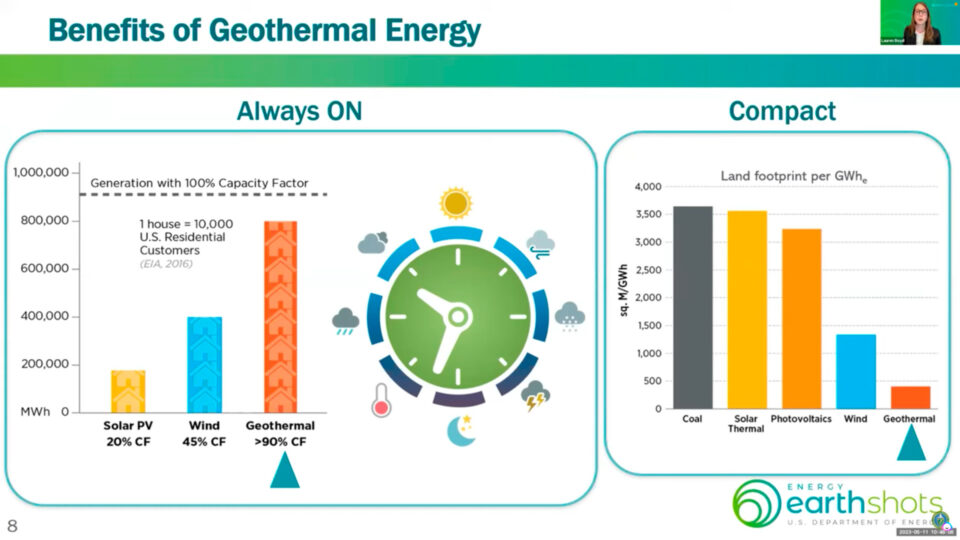Geothermal Energy: Harnessing Earth’s Heat for a Sustainable Future
Geothermal energy is abundant and sustainable. It is essentially heat from the earth, has been radiating from the Earth’s core for millions of years, and will continue to do so for billions more. This virtually inexhaustible heat can be utilized in various ways, depending on its temperature range.
A Plethora of Applications: From Homes to Electric Power
Lauren Boyd, a representative from the Department of Energy, explains the diverse applications of geothermal energy across different temperature spectrums. At the lower end, geothermal energy can provide heating and cooling for homes and buildings. As temperatures rise, entire communities can be heated, and greenhouses can extend growing seasons. Remarkably, geothermal energy can generate clean and dispatchable electric power at higher temperatures.
Why Geothermal Energy Matters: Abundant Resources and Enormous Potential
Lauren Boyd highlights the significance of geothermal energy for the United States. The map illustrates the abundance of stranded heat resources stored beneath us, surpassing the global energy demand. The Earthshot initiative aims to innovate ways to access and harness as much of this resource as possible, positioning geothermal energy as a crucial contributor to the country’s energy portfolio.
Advancing Technology for a Powerful Future
By improving and developing technologies related to Enhanced Geothermal Systems (EGS), there is potential to generate 90 gigawatts of clean, dispatchable power, equivalent to approximately 12% of U.S. power generation in 2015. The progress made in EGS can also benefit other forms of geothermal energy, creating opportunities for various applications, including geothermal heat pump systems and direct-use markets. These advancements open doors for emissions reductions and offer sustainable solutions for urban, rural, and remote communities.
Geothermal Power Sector: Conventional vs. Enhanced Geothermal Systems
Lauren Boyd delves into the geothermal power sector, distinguishing between conventional geothermal resources and Enhanced Geothermal Systems (EGS). While conventional resources are limited to specific areas with natural hot water sources, EGS allows the creation of human-made reservoirs. By injecting fluid into hot rocks, EGS increases heat extraction efficiency, enabling power generation from previously untapped regions.
Firm, Resilient, and Dispatchable: The Advantages of Geothermal Power
Geothermal energy possesses unique attributes that make it an invaluable asset in the energy transition. Geothermal power plants provide firm, resilient, flexible, and dispatchable electricity, ensuring a reliable power supply. With a high capacity factor and operational flexibility, geothermal power plants outperform wind and solar plants, making them ideal for balancing daily and seasonal loads, especially in regions with intermittent renewable energy sources.
Efficiency and Compactness: Geothermal Power’s Footprint
Geothermal energy stands out for its remarkable efficiency and compactness. Unlike other energy sources, geothermal power plants have a smaller physical footprint since most infrastructure operates underground. This space-saving characteristic makes geothermal energy an attractive option for areas with limited land availability.
Geothermal energy has gained recognition for its high efficiency in line with the pursuit of sustainability and cost-effectiveness. Geothermal power plants can generate two to four times more electricity than wind or solar plants of the same capacity. With its baseload capacity and operational flexibility, this efficiency has led to mandates and incentives for utilities to invest in geothermal resources, ensuring long-term grid stability and lowering costs.
Looking ahead, the potential of geothermal energy extends far beyond power generation. As technological advancements continue, geothermal applications will expand, providing solutions for heating and cooling needs in all 50 states. From urban environments to rural and remote communities, geothermal heat pumps and direct-use systems offer opportunities for sustainable and affordable heating and cooling solutions.
Furthermore, the widespread adoption of geothermal energy can lead to substantial emissions reductions. By replacing fossil fuel-based heating and cooling systems with geothermal alternatives, significant progress can be made toward achieving climate targets and creating a cleaner, greener future.
Geothermal Energy Full Potential
The journey toward unlocking the full potential of geothermal energy requires ongoing research, innovation, and collaboration. The U.S. Department of Energy, alongside industry partners and stakeholders, is committed to advancing Enhanced Geothermal Systems and promoting the widespread adoption of geothermal energy.
In conclusion, geothermal energy is a promising pillar in the quest for a sustainable energy future. Its abundance, versatility, and environmentally friendly characteristics make it valuable in transitioning to clean and renewable power sources. With continued investment and support, geothermal energy has the potential to reshape the energy landscape, providing reliable and carbon-free electricity while paving the way for a greener and more resilient tomorrow.
Link of interest: Clean Fuels & Products


